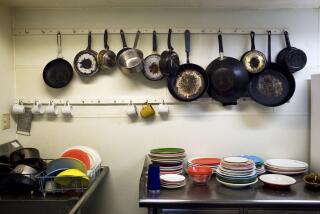More Meeting Planners Use Country Inns : Hospitality: Boosters say corporate creativity flourishes in their smaller, more intimate conference settings.
- Share via
WAITSFIELD, Vt. — Near one wall of the 83-year-old barn stands a row of stanchions just waiting for the Holsteins to file in for milking and feeding.
But there will be no cows in this barn any time soon. More likely a herd of business men and women will be filing in and filling the white plastic chairs across the room, arranged in a semicircle by the silo that rises up through the center of this historic round barn.
For the past five years, the Inn at the Round Barn Farm has been hosting not only the vacationers so common to country inns but also groups of business leaders looking for an alternative to the large, often impersonal urban hotels that historically have hosted corporate America’s meetings.
The inn’s operators have found plenty of demand because corporate meeting planners increasingly are turning to smaller, more intimate country inns and bed-and-breakfasts.
Although the trend seems to be nationwide, it is most pronounced in the Northeast, where it began and where so many large companies are based, and the California coast, home to countless small inns, said Ron Callari, founder of INNovations Inc., a New Jersey firm that specializes in scheduling business meetings at country inns.
The trend is about three years old, and inn owners are working hard to capitalize on it.
“One of the reasons the trend is turning to smaller inns is the customer service,” said Anne Marie Defreest, who owns the Round Barn Inn with her parents, Jack and Doreen Simko.
“I think a lot of it is because of the economy, companies have shied away from big huge travel and expense budgets,” she said. “Inns tend to be less expensive than major hotels. We don’t charge for every soft drink they have. We don’t charge for every cup of coffee they have.”
Many meeting planners agree. But they say a country inn’s superior atmosphere has driven the switch. Too often, the ideas hatched in the sometimes sterile surroundings of an urban hotel produce similarly dull results.
Country inns, they say, seem to have the opposite effect, relaxing meeting participants and inspiring a creativity that seems elusive in the boardroom, a busy office or city hotel. Even an old, restored country barn gets the creative juices flowing.
“The atmosphere is considerably different than a standard hotel, especially if you have a meeting where you’re looking to stimulate creativity,” said Wendy Denn, East Coast representative for the California-based Professional Assn. of Innkeepers International.
Meeting planners seeking small, intimate places for small, multi-day business sessions want the personal service for which country inns are so well known. But they also want adequate space. So inns give over formal sitting parlors, dining rooms and they even cover pool tables in game rooms to set up clients’ computers.
The Inn at the Round Barn Farm is one that has gone even further, renovating the three floors of its big old barn into a conference center capable of accommodating 200 or more people. But the owners had no idea at the time of renovation what they were creating.
“We basically restored our barn because it was a historic landmark and it was falling down,” Defreest said. “Since we’ve restored it and kept its integrity and didn’t turn it into anything, we really did ourselves a favor because it can accommodate anything.”
Marketing toward country inn meeting events has become a cottage industry of its own. Callari said he spent five years researching the market for promoting such properties before establishing INNovations.
“We wouldn’t have done it if this weren’t a growing trend,” he said.
Because there is such a variety of meetings hosted around the country every day and a corresponding variety of inns, he said, almost any property is a potential meeting site.
For some inns, the meeting business has made the difference between turning a profit and barely making ends meet. Although Defreest said her inn makes money on its traditional traveler business and the many non-business meeting events it hosts in the barn, such as weddings and music concerts, the business meetings make a big difference.
During the slow time in April, it means the difference between a 45% occupancy rate and as much as 60%, she said. “In the off-season, it’s what makes or breaks the season,” she said. “You’re not losing money, basically.”
More to Read
Inside the business of entertainment
The Wide Shot brings you news, analysis and insights on everything from streaming wars to production — and what it all means for the future.
You may occasionally receive promotional content from the Los Angeles Times.









